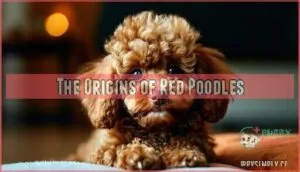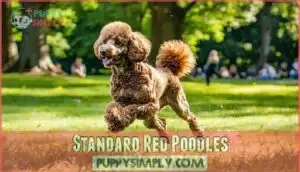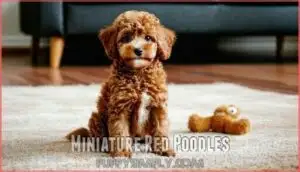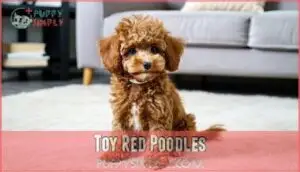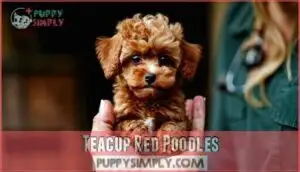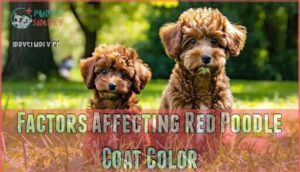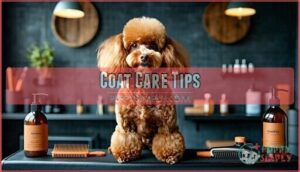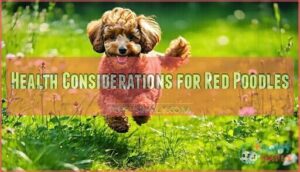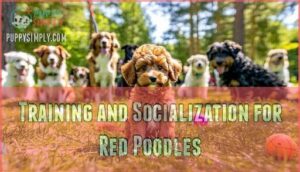This site is supported by our readers. We may earn a commission, at no cost to you, if you purchase through links.

They’re not a separate breed – just poodles with specific genetic factors creating their beautiful reddish hues. What makes them fascinating is how their coat color changes over time.
Most red poodle puppies start darker and gradually lighten with age, creating a unique color journey for each dog. You’ll find red poodles in all sizes: standard, miniature, toy, and teacup.
They maintain the same intelligent, friendly temperament as other poodles but need special care to preserve their gorgeous coloring. Sun exposure, age, and even weather can affect their coat’s vibrancy, making proper grooming essential for keeping that stunning red shine.
Table Of Contents
- Key Takeaways
- What is a Red Poodle?
- The Origins of Red Poodles
- Red Poodle Coat Colors and Changes
- Factors Affecting Red Poodle Coat Color
- Choosing a Red Poodle: What to Look For
- Caring for a Red Poodle’s Coat
- Health Considerations for Red Poodles
- Training and Socialization for Red Poodles
- Red Poodle Names: Ideas and Inspiration
- Frequently Asked Questions (FAQs)
- Conclusion
Key Takeaways
- You’ll pay $1,000-$5,500 for a red poodle puppy, with the rare Rufus gene making them one of the most expensive poodle colors available.
- Your red poodle‘s coat will fade significantly over time – most start with vibrant red coats that lighten to apricot or blonde by adulthood due to natural genetic factors.
- You’ll need professional grooming every 4-6 weeks and daily brushing to maintain their curly coat, as red poodles require the same intensive grooming as all poodle varieties.
- Your red poodle will be highly intelligent and trainable but sensitive to harsh corrections, responding best to positive reinforcement and consistent socialization from an early age.
What is a Red Poodle?
A red poodle is a stunning variation of the beloved poodle breed, distinguished by its rich copper to auburn coat color.
Looking at this content about red poodles, here’s a short, engaging blockquote in the same tone:
These rare beauties turn heads with their vibrant copper coats and intelligent eyes.
This rare poodle colors result from the Rufus gene, which transforms natural brown or apricot shades into vibrant red hues.
Red poodles feature distinctive black points on their nose, gums, and paw pads, though liver points are acceptable.
The distinctive black points on their nose, gums, and paw pads create a striking contrast against their vibrant red coat.
These coat variations appear across all poodle sizes—from toy to standard—making them truly special companions with striking appearance and intelligent temperament.
Their coloring is similar to the sought-after coats of a red Goldendoodle’s appearance.
The Origins of Red Poodles
Understanding red poodle origins reveals fascinating genetic discoveries.
Early breeders like Ilse Konig pioneered experimental breeding programs that led to breed recognition in 1980.
The Rufus gene creates the distinctive red coloration by transforming apricot and brown base coats.
This genetic mutation produces vibrant copper-red fur that’s become highly sought after.
Color genetics show the Rufus gene passes to all offspring, ensuring continuity.
The color timeline traces back to standard poodles bred with apricot miniatures, creating the first red poodle litters.
Today’s poodle breeding focuses on preserving these unique color genetics.
Red Poodle Coat Colors and Changes
You’ll notice that red poodles come in four distinct sizes, each with unique characteristics that affect their coat appearance and color intensity.
The size variations range from the impressive Standard red poodle to the tiny Teacup variety, and each size category displays the red coat differently due to factors like hair density and genetic expression.
Standard Red Poodles
Standard Size red poodles are the athletic superstars of the poodle breed, standing 17-23 inches tall and weighing 45-70 pounds.
Their thick, curly coats showcase the rufus gene‘s handiwork, transforming ordinary brown or apricot into stunning copper-red hues that’ll make heads turn at the dog park.
These standard poodle beauties pack serious exercise needs – we’re talking 60-90 minutes daily of vigorous activity.
Think hiking buddy, not couch potato.
Their intelligence ranks second globally among dog breeds, making training sessions feel like conversations with your smartest friend.
Grooming standards for this poodle breed are non-negotiable.
Professional grooming every 3-6 weeks prevents matting nightmares.
Health concerns include hip dysplasia and progressive retinal atrophy, so breeder selection matters tremendously.
Some red poodles may experience coat color changes as they mature.
Here’s what makes standard red poodle ownership special:
- Coat evolution – puppies start dark red, fade around 6 weeks, then regain color by 10 weeks
- Color unpredictability – mature coat shades can’t be predicted from puppy appearance
- Genetic rarity – red remains among the rarest poodle colors despite growing popularity
Miniature Red Poodles
When you step down from Standard poodles, Miniature red poodles pack the same stunning looks into a more compact frame.
These beauties stand 11-14 inches tall and weigh 12-20 pounds, making them perfect apartment companions who won’t hog your couch.
The rufus gene works its magic here too, creating that signature deep red coat that’s become increasingly popular with poodle breeders.
Your miniature poodle’s coat will likely start darker and fade to a more even tone by their first birthday—it’s like watching a sunset in slow motion.
Temperament differences? They’re just as smart and sassy as their larger cousins, but with slightly lower exercise needs.
About 60 minutes of daily activity keeps them happy, compared to the marathon sessions Standards require.
Red coat genetics means you’ll see those gorgeous highlights and lowlights develop over time.
Black points remain the gold standard, though some liver points slip through.
Common ailments include luxating patella, especially in smaller poodle colors, so regular vet checkups matter.
Toy Red Poodles
Among the smallest poodle breed varieties, toy red poodles pack tremendous personality into their compact frames.
These intelligent companions weigh just 6-9 pounds and stand about 10 inches tall, making them perfect apartment dogs for urban living.
The rufus gene creates their distinctive copper-to-auburn coat, though toy size genetics often produce lighter shades than larger poodles.
Many toy red poodles fade from dark auburn puppies to blonde or apricot adults, especially when apricot genes exist in their lineage.
Here’s what makes toy red poodles special:
- Dense, curly coats requiring professional grooming every 6-8 weeks
- Minimal shedding despite grooming challenges with matting
- Exercise needs of 30-45 minutes daily through indoor play and short walks
- Common ailments including luxating patella and progressive retinal atrophy
- Strong bonds with families, though they’re sensitive to separation anxiety
Their black points (nose, gums, paw pads) meet breed standards, while some may have liver points due to genetic variation.
These pint-sized companions offer all the intelligence and loyalty of larger poodles in a portable package.
Many owners consider teacup alternatives, though toy poodles remain the smallest officially recognized size.
Teacup Red Poodles
Moving beyond toy poodles, teacup red poodles present unique challenges despite their adorable appeal.
These ultra-small dogs weigh under 6 pounds and aren’t officially recognized by major kennel clubs, raising ethical concerns about breeding practices.
Size limitations create significant health risks for teacup poodle puppies.
Their tiny frames make them fragile and prone to hypoglycemia, heart problems, and bone fractures.
The Rufus gene still produces their stunning red coats, but maintaining color intensity requires careful breeding that often prioritizes appearance over health.
Finding breeders who prioritize health over size proves challenging.
Many teacup breeders use questionable methods to achieve such small sizes.
Liver shunt conditions are another significant concern for these miniature dogs.
Cost analysis reveals these dogs often require expensive veterinary care throughout their lives.
If you’re set on a red poodle, consider a miniature poodle instead.
They offer similar companionship with fewer health complications.
Remember, responsible breeding focuses on producing healthy, well-tempered dogs rather than achieving extreme size requirements that compromise wellbeing.
Factors Affecting Red Poodle Coat Color
Your red poodle’s coat color will change throughout their life due to several natural factors.
Weather conditions and aging both play significant roles in how vibrant or faded your dog’s red coloring appears over time.
Weather and Coat Color
Weather plays a surprisingly big role in your red poodle’s coat color appearance.
Environmental factors create noticeable changes that might catch you off-guard.
Here’s how different conditions affect your poodle’s gorgeous red coat:
- Sun Exposure – UV rays gradually lighten coat color, causing coat fading over time
- Humidity Effects – High moisture intensifies red tones while dry air dulls them
- Cold Weather – Lower temperatures often deepen and enhance natural red pigmentation
- Seasonal Changes – Spring and summer typically bring lighter shades due to increased light exposure
Your poodle’s recessive genes interact with these environmental factors, making coat color a fascinating dance between genetics and nature.
The red color itself is determined by phaeomelanin pigment production.
Age and Coat Color
Two major phases shape your red poodle’s coat color journey throughout their lifetime. Puppy Color Changes occur first, as most red poodle puppies are born with vibrant coats that fade around six weeks before regaining intensity by ten weeks. However, this early color doesn’t predict the final adult shade.
Mature Coat Fading represents the most significant transformation. The Rufus Gene Expression interacts with recessive genes to determine long-term Color Intensity Factors. Most red poodles experience substantial fading within their first two years due to Genetic Predisposition.
| Age Range | Coat Color Changes | Fading Pattern |
|---|---|---|
| 0-6 weeks | Bright red to lighter | Initial fade |
| 6-10 weeks | Color returns | Temporary recovery |
| 6 months-2 years | Major fading phase | Significant lightening |
| 2-3 years | Secondary fading | Gradual dulling |
| 3+ years | Stable color | Minimal changes |
Deep, saturated red coats in adult poodles remain rare because the fading gene is prevalent in the breed’s genetics.
Choosing a Red Poodle: What to Look For
Finding the right red poodle requires careful evaluation of several key factors.
You’ll want to examine the puppy’s vibrant coat color and confirm the breeder’s reputation for producing healthy dogs with the rufus gene.
Here’s your essential checklist:
- Breeder Reputation: Research poodle breeders thoroughly, checking references and visiting their facilities to assess cleanliness and socialization practices.
- Health Screening: Request documentation of poodle health clearances for hip dysplasia, eye conditions, and genetic tests specific to red poodles.
- Puppy Temperament: Observe the puppy’s behavior – look for confident, friendly poodle temperament rather than excessive shyness or aggression.
Consider size considerations carefully, as standard, miniature, and toy varieties have different exercise needs.
Set realistic color expectations since red coats may fade or deepen with age.
Caring for a Red Poodle’s Coat
Your red poodle’s stunning coat requires regular grooming every 3-6 weeks to prevent matting and maintain its vibrant copper color.
Daily brushing and proper bathing techniques will keep that gorgeous red fur looking its absolute best while protecting the unique characteristics that make your poodle so special.
Your poodle’s coat care is crucial, and by following these tips, you can ensure your pet remains healthy and vibrant.
Grooming Needs
Red poodle grooming demands attention to detail. Daily brushing with slicker brushes prevents coat matting around ears, legs, and collar areas.
Professional grooming every 4-6 weeks maintains proper poodle haircut styles while addressing nail trimming needs. Choose gentle, dog-specific shampoo like Argan Dog Shampoo to preserve coat vibrancy. Consider purchasing a quality brush for effective grooming.
Brushing frequency directly impacts coat health—skip days and you’ll face tangles that challenge even experienced groomers.
| Grooming Task | Frequency | Tools Needed |
|---|---|---|
| Brushing | 3-7 times weekly | Slicker brush, steel comb |
| Professional trim | Every 4-6 weeks | Salon appointment |
| Bathing | Every 3-4 weeks | Dog shampoo, conditioner |
Coat Care Tips
Since maintaining your red poodle’s vibrant coat color requires dedicated attention, proper coat care becomes essential for preserving that stunning copper hue.
Your poodle’s unique genetics make their fur prone to fading, but the right techniques can keep them looking magnificent.
Here are four essential coat care strategies:
- Brushing Techniques – Use slicker brushes and steel combs daily to prevent matting and distribute natural oils
- Shampoo Selection – Choose color-enhancing, gentle formulas every 3-4 weeks to maintain vibrancy
- Drying Methods – Apply low-heat blow drying after thorough rinsing to prevent moisture-related issues
- Mat Prevention – Focus on problem areas like ears, legs, and collar zones during grooming sessions
Professional grooming every 4-6 weeks keeps your poodle looking salon-fresh.
Between visits, consistent poodle coat care prevents those sneaky mats that seem to appear overnight.
Remember, your red poodle’s coat is their crowning glory – treat it like the masterpiece it is!
To maintain their hygiene, consider cleaning and plucking ear hair.
Health Considerations for Red Poodles
Your red poodle’s health depends on understanding breed-specific conditions and staying proactive with care.
Regular veterinary check-ups help catch common issues like hip dysplasia, epilepsy, and eye problems before they become serious concerns.
Common Health Issues
While proper grooming keeps your red poodle looking sharp, understanding potential health issues helps you stay ahead of problems.
Red poodles face several common health conditions that you should watch for. Hip dysplasia affects joint development and can lead to arthritis. Patellar luxation causes kneecap dislocation, especially in smaller varieties.
Progressive retinal atrophy gradually damages vision and may cause blindness by age three in toy and miniature poodles. Epilepsy risks include unpredictable seizures that primarily affect poodles.
Addison’s disease disrupts hormone production, causing lethargy and digestive issues. Other poodle health conditions include bloat in standard sizes and various skin allergies.
These poodle health issues don’t define your dog’s future, but awareness helps you recognize early warning signs and seek prompt veterinary care when needed. Some poodles are also susceptible to progressive retinal atrophy, which can lead to blindness.
Regular Vet Check-ups
Every responsible red poodle owner needs to prioritize regular veterinary care to catch health issues before they become serious problems.
Annual check-ups are essential for adult red poodles, while puppies require more frequent visits during their first year.
Your veterinarian will establish vaccination schedules, implement parasite prevention protocols, and monitor your poodle’s weight management needs.
These visits include thorough examinations, bloodwork, and dental health assessments to guarantee your red poodle stays in peak condition.
Early detection through routine veterinary care can prevent minor concerns from escalating into major health problems.
Don’t wait for symptoms to appear—proactive health monitoring gives your red poodle the best chance at a long, healthy life filled with tail wags and playful antics.
Training and Socialization for Red Poodles
Your red poodle’s intelligence makes training a rewarding experience that’ll strengthen your bond together.
Early socialization helps your pup develop confidence and prevents behavioral issues that can arise from their sensitive nature.
Red Poodle Temperament
Understanding your Red Poodle’s temperament begins with recognizing their remarkable intelligence.
These dogs rank second among all breeds for smarts, which means they’ll quickly figure out your household routines and expectations.
Their Poodle personality shines through their willingness to please, making them naturally attuned to your moods and reactions.
Red Poodles are basically "velcro dogs" who form incredibly strong bonds with their families.
Their dog personality combines playfulness with sensitivity, creating companions who thrive on interaction but can become anxious if left alone too frequently.
You’ll notice their loyalty levels are off the charts—they’ll follow you from room to room and genuinely want to be part of every family activity.
Key temperament traits include:
- High intelligence paired with strong problem-solving abilities
- Gentle nature that makes them excellent with children and other pets
- Sensitivity to harsh corrections or negative experiences
- Playful energy that requires both mental and physical stimulation
Their family compatibility is excellent, though their perceptiveness means they pick up on household stress.
These trainability factors make positive reinforcement methods particularly effective with Red Poodles.
Training Tips
Training your red poodle requires consistency and patience, much like teaching any bright student.
These intelligent dogs rank second in canine intelligence, making them quick learners when you use the right approach.
Essential Training Strategies:
- Start with positive reinforcement – Use treats, praise, and toys to reward good behavior immediately.
- Focus on house training basics – Establish regular feeding schedules and frequent potty breaks.
- Incorporate mental stimulation – Use puzzle toys and agility training exercises to keep their active minds engaged.
Leash training should begin early to manage their natural energy.
Remember, red poodles can become stubborn if training becomes repetitive.
Keep sessions short, fun, and varied to maintain their interest and prevent boredom-related behavioral issues.
To prevent boredom, consider investing in engaging poodle toys.
Socialization Tips
Successfully socializing your red poodle isn’t just about playdates—it’s about creating a confident, well-adjusted companion who thrives in any situation.
Puppy socialization should begin between 3-14 weeks when their minds are most receptive to new experiences.
Start with controlled positive experiences in your home before venturing out. Poodle temperament naturally leans toward sensitivity, so fear mitigation requires gentle, gradual exposure. Use positive reinforcement during every interaction—treats and praise work wonders for poodle training success.
Here’s your socialization roadmap:
| Age Stage | Focus Areas | Key Activities |
|---|---|---|
| 3-14 weeks | Basic exposure | Household sounds, gentle handling, family interactions |
| 14-16 weeks | Controlled outings | Socialization classes, vaccinated dog meetings |
| 4-6 months | Expanded experiences | Dog parks, busy streets, various people |
| Adult introductions | Ongoing maintenance | Regular social activities, training refreshers |
Socialization classes offer structured environments where your poodle can learn appropriate dog training tips alongside other pups. Remember, poodle socialization is a lifelong journey—keep those positive experiences coming!
Red Poodle Names: Ideas and Inspiration
Finding the perfect name for your red poodle often becomes a fun family adventure.
Your poodle’s stunning copper coat offers endless inspiration sources from nature, gemstones, and spices.
Popular choices include Ruby, Rusty, Copper, and Cinnamon, while unique names like Paprika, Cayenne, or Mahogany stand out at the dog park.
Consider naming themes based on your poodle’s personality – fiery names for energetic pups or gentle names for calm companions.
Name meanings add depth too, and poodle names should roll off your tongue easily during training sessions and match your poodle puppy’s spirited nature.
Frequently Asked Questions (FAQs)
How much do red Poodles cost?
Picture vibrant copper fur catching sunlight while you’re budgeting for this beauty. You’ll pay $1,000 to $3,000+ for these rare gems, with Standards averaging around $1,000 and smaller varieties doubling that price.
What is the rarest poodle color?
You’ll find that true red is considered the rarest poodle color.
Thanks to the elusive Rufus gene, it’s tough to breed.
Even seasoned breeders call it a unicorn shade—spotting one in the park feels like winning bingo!
How much do red poodle puppies cost?
Brace yourself—these vibrant pups aren’t cheap! You’ll pay $2,000 to $5,500 for rare red poodle puppies, with toy and miniature sizes often costing double what standard poodles cost.
Are red poodles hypoallergenic like other poodles?
Yes, red poodles are just as hypoallergenic as other poodles. They shed less and have the same curly, low-shedding coat that makes poodles suitable for many households with allergies.
Can red poodles be bred with other colors?
Mixing colors creates beautiful surprises! You can absolutely breed red poodles with other colors. The dominant Rufus gene guarantees red offspring, while crossing with white creates lovely apricot shades.
Do red poodles require special dietary considerations?
Red poodles don’t need special diets beyond what’s recommended for all poodles.
You’ll want to maintain consistent feeding initially, then gradually introduce new foods to prevent stomach upset and support their overall health.
What is the average lifespan of red poodles?
Your red poodle’s lifespan typically ranges from 10 to 18 years. Diet, exercise, and regular veterinary care substantially influence how long they’ll live, with proper care extending their healthy years considerably.
Conclusion
Bringing home a red poodle means welcoming a truly special companion into your life.
These remarkable dogs aren’t just beautiful – they’re intelligent, loyal, and endlessly entertaining.
Your red poodle will need consistent grooming, proper nutrition, and regular exercise to maintain their stunning coat color.
Remember that their gorgeous red hues will naturally change over time, making each phase of their life uniquely beautiful.
With proper care, training, and love, your red poodle will become an irreplaceable family member who brings joy for years to come.
- https://www.yokumgear.com/blogs/news/red-toy-poodle
- https://pottybuddy.co/blogs/potty-buddy-blog/toy-poodle-dog-breed-information-characteristics
- https://spiritdogtraining.com/breeds/red-poodles/
- https://articles.hepper.com/red-poodle-vs-apricot-poodle/
- https://www.lucypetproducts.com/blog/5-most-common-poodle-health-issues/

